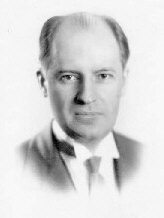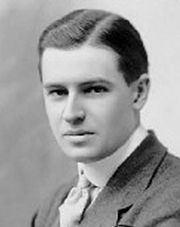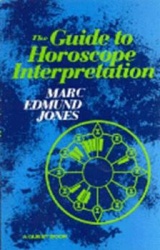Marc Edmund Jones
ARTICLE UNDER CONSTRUCTION
ARTICLE UNDER CONSTRUCTION
Marc Edmund Jones was an American astrologer, writer, Presbyterian minister, Theosophist, and lecturer. He has been called "the dean of American astrology." He founded the Sabian Assembly in 1923, and made major contributions to the advancement of astrology through the Sabian Symbols and a system of planetary patterns relating to temperament types. For a detailed biographical sketch, see the Sabian Assembly website.
Personal life
Marc Edmund Jones was born in St. Louis on October 1, 1888. His parents were Edmund H. Jones, a dealer in building materials, and Anna Louise Holmes Jones. The family moved to Chicago, where Marc's sister Helen was born in 1897. After his schooling, Marc worked as a stenographer at the Pullman Company.[1] By 1913 he was working as a writer in the new silent film industry, and lived in New York and in California, where the production companies were based. He was called up to military duty during World War I, and after a few months in the Army was honorably discharged on November 23, 1918.[2] Around 1923 he married Priscilla Kennedy.
Marc Jones was energetic and entrepreneurial. He submitted scenarios (scripts) to film producers, and was very active as a lecturer. During the 1940s he and Priscilla lived in Manhattan, and then around 1952 settled in the Seattle area.
Priscilla Jones died on February 18, 1976 in Snohomish, Washington.[3] Dr. Jones died on March 5, 1980 at Sedro-Wooley, Washington, at the age of 91.[4].
He left a great legacy in his writings and students. These are the closing lines of his healing ritual:
May the temple of your living flesh
Be worthy of your high desire;
May your worldly place in daily life
Bring recompense in rich degree;
May your happiness and state of heart
Endear you everywhere you go;
And may the spirit stirring deep within
Be ever conscious in your thoughts!
Career as a writer
Dr. Jones was a very prolific and inventive writer in several genres.
Screenwriting
Jones worked in the early days of filmmaking as a prolific and highly regarded screenwriter, or "photoplaywright," described as "one of the cleverest scenario writers and movie picture experts in the country."[5] He wrote original stories and adapted novels into "scenarios" for silent films. In 1912 he sold his first scenario, Twilight, and went on to sell 13 in 1913 and 39 in 1914. During the silent film era, writers were present during production of the film, because the process was very improvisational. When writing episodes of the Runaway Jane series, Jones was with the Reliance production company as they traveled from their base in New York to Bermuda:
Marc Edmund Jones will work into his scenarios every interesting feature of the island and diving and submarine scenes will also be completed before the Runaways run back to New York.[6]
He was honored by his peers at a banquet of the New Orleans Inquest Club in 1913:
Mr. Jones is one of the best-known photoplaywrights in the country, and is the author of many screen successes. He will remain in the city until the month of March, and it is the intention of the local writers to extend him a hearty welcome. The banquet, which promises to be a swell affair, will be given at Fabacher's Rathskeller.[7]
In 1914 he worked with Russell D. Smith, Hattie Gray Baker, and other writers of the Mutual Film Corporation to establish the Photoplay Authors' League, a organization that lobbied on behalf of its members at a time when films were not protected by the First Amendment in the United States.[8] By 1919 was also a member of the Green Room Club, Playwright's Club, Authors' League, and Photodramatists' Club.[9]
Fiction
During the time he was linked to the film industry, Jones wrote novelizations of popular films. He also wrote dozens of short stories for pulp magazines. Most were on romantic and comic themes. In the 1960s he introduced a series of astrological detective stories featuring the character Grandon Trine.
Christian ministry
Astrological work
Theosophical Society involvement
Jones was admitted as a member of the Theosophical Society on January 13, 1941. He joined in his home town of St. Louis, where the lodge was for a few years affiliated directly with the international headquarters rather than with the Theosophical Society in America. The President of the St. Louis Lodge was the industrialist Charles Luntz, who was an excellent teacher of astrology and editor of a Theosphical magazine called Ancient Wisdom. Later Jones was active with TSA lodges in Columbus, Ohio and Seattle, Washington, and he remained a member until his death in 1980. His wife, Priscilla, was also a member from June 30, 1951 until her death in 1976.
Dr. Jones was much in demand as a lecturer in Theosophical lodges all over the United States, especially from 1948-1959. He spoke in Los Angeles, San Francisco, Detroit, Philadelphia, Miami, Washington, San Antonio, Wilmington, and many other cities. He conducted a workshop at Camp Indralaya, a Theosophical retreat center near Seattle. In 1976, at the age of 88, he lectured at the Society's national headquarters in Wheaton, Illinois. The topics of his lodge lectures were usually related to Theosophy, astrology, religion, history, and culture. Some of the titles are:
- "Theosophical Perspectives on Astrology"
- "Unrealized Christian Factors in Theosophy"
- "The Meaning of Eastern Teachings in the Western World Today"
- "The Crazy Quilt of History and Some Answers Theosophy Provides"
- "The Mother Principle of God"
- "Theosophy and the Feminization of Our Culture"
- "The New Look in Mundane Astrology"
- "The Cabala and Today's Crisis"
- "The Astrology of Initiation"
Editions of some of Jones' books, including How To Live With The Stars and The Guide To Horoscope Interpretation, were published by the Theosophical Publishing House.
Writings
Film credits
These are some of the film scenarios he wrote:
- Twilight, 1912 - the first scenario he sold, for $20.
- In the Firelight, 1914 - in a series of 6 fhort films directed by Thomas Ricketts.
- In the Moonlight, 1914 - in a series of 6 fhort films directed by Thomas Ricketts.
- In the Daylight, 1914 - in a series of 6 fhort films directed by Thomas Ricketts.
- In the Candle Light, 1914 - in a series of 6 fhort films directed by Thomas Ricketts. Two reels.
- Out of the Haunted Past, 1914 - #44 in the Our Mutual Girl series of one-reel films.
- The Town of Nazareth, 1914 - directed by Thomas Ricketts.
- In the Twilight, 1915 - in the "Flying A" series of 6 films directed by Thomas Ricketts. Two reels.
- The Cowardly Way, 1915 - on suicide.
- Fate and the Fugitive, 1915 - a man is falsely accused for the crimes of a double.
- Runaway June, 1915 - Jones adapted a screenplay from a George Randolph Chester novel. The film was presented as 15 short weekly episodes. Limited access at Hathitrust and Hathitrust.
- Tears and Smiles, 1917.
- Loyalty of a Race, 1918 - 4-reel film commissioned by the National Colored Soldiers' Comfort Committee, and performed by "colored" actors in 150 scenes.
- Skin Deep, 1922 - produced by Thomas H. Ince, was based on Jones' novel "Lucky Damage."
Novelizations of films
Jones turned silent films into popular novels:
- Land of the Rising Sun; Based upon the Stirring Account of Japanese Life and Affairs. Philadelphia, D. McKay Company, 1943. Story by James R. Young. Original screen play by Emmet Lavery; novelized version by Marc Edmund Jones.
- The Mystery Mind. New York: Grosset & Dunlap, 1920. "By Arthur B. Reeve and John W. Grey; illustrated with photographic reproductions taken from the [silent movie] serial of the same name ... ; novelization by Marc Edmund Jones." Available at Hathitrust, Hathitrust, and Google Books.
- The Voice of Calliope; the Romance of the Pipe Organ. Los Angeles, J.F. Rowny Press, 1926.
Short stories
The bibliographic website of Galactic Central Publications lists over 30 short stories that Jones wrote, including titles such as these:
- "Her First Suspicion", Argosy Jun 7 1919.
- "Love in St. Louis", Argosy All-Story Weekly Oct 30 1920.
- "Death’s Bridegroom", The Black Mask Apr 1921.
- "Hour-a-Day Hadley", Short Stories Sep 10 1922.
- "Flapperella", Telling Tales Oct 1922.
- "Murder at Malden Manor", New Dimensions Apr/May 1963.
- "A Murder for a Murder", New Dimensions Oct/Nov 1963. A Grandon Trine story.
Books on Astrology and the Occult
Jones wrote over 20 books about astrology and the occult, and many are reviewed in the Sabian Assembly website. The titles are listed here in alphabetical sequence:
- Astrology Books: A Commentary. Stanwood, Wash.: Sabian Pub. Society, 1987. 25 pages.
- Astrology: How & Why It Works: an Introduction to Basic Horoscopy. Philadelphia: David McKay Co., 1945. Several other editions. Serialized in abridged form in American Astrology magazine from February, 1940, through January, 1941. Limited access at Hathitrust and Open Library.
- The Counseling Manual In Astrology: a Long-tested Method for Accuracy. Tempe, AZ: American Federation of Astrologers, 1979.
- Essentials Of Astrological Analysis: Illustrated in the Horoscopes of One Hundred and Seventy-four Well-known People. Stanwood, Washington: Sabian Pub. Society, 1960. Several editions.
- Fundamentals Of Number Significance: an Autobiographical Account of Accomplishment. Stanwood, Wash.: Sabian Pub. Society, 1978.
- The Guide To Horoscope Interpretation. Philadelphia: David McKay Co., 1941. Quest Books released a miniature version in 1975, and there have been several other editions. Limited access at Internet Archive, Hathitrust, and Open Library.
- Horary Astrology: the Technique of Immediacies, with a Primer of Symbolism . Philadelphia, D. McKay, 1943. Several other editions, some under the title Problem Solving by Horary Astrology. Limited access at Hathitrust and Google Books.
- How To Learn Astrology. Philadelphia: David McKay Co., 1941. Philadelphia, D. McKay, 1941. Numerous other editions, including French. Limited access at Internet Archive and Open Library.
- How To Live With The Stars: Simple, Personal Astrology. Wheaton, IL: Theosophical Publishing House, 1975.
- Key Truths of Occult Philosophy: an Introduction to the Codex Occultus. Los Angeles: J.F. Rowny Press, 1925. Available at Hathitrust.
- Man, Magic And Fantasy: the Domestication of Imagination. Stanwood, Wash.: Sabian Pub. Society, 1978. Limited access at Hathitrust.
- The Marc Edmund Jones 500. New York: ASI Publishers, 1978.
- Mundane Perspectives In Astrology: the Expanded Dynamic Horoscopy. Stanwood, Wash.: Sabian Pub. Society, 1975.
- Occult Philosophy: an Introduction, the Major Concepts, and a Glossary. Philadelphia, McKay, 1947. Several editions, including Spanish.
- Patterns Of Consciousness: The Ibn Gabirol Squares. Infinity Publishing, 2010.
- Philosophy of Concepts. 1958. Originally issued between 1928 and 1934. Philosophy of Concepts is a subset of The Sabian Manual as listed in the Sabian Library of Lessons.
- The Sabian Book Of Letters To Aspirants'. Stanwood, Wash.: Sabian Pub. Society, 1973. Selection and commentary by Helen Rentsch and Helen Hill.
- The Sabian Manual: A Ritual For Living. New York: Sabian Pub. Society, 1957.
- The Sabian Symbols In Astrology. New York: Sabian Publishing Society, 1953. Numerous editions including German. Subtitle: "Illustrated by one thousand horoscopes of well-known people."
- The Scope Of Astrological Prediction: an Introduction to the Dynamic Horoscopy. Stanwood, Wash.: Sabian Publishing Society, 1969.
- Ten Words of Power: a New Age Interpretation of the Ten Commandments. Stanwood, Wash.: Sabian Pub. Society, 1987.
Biographies
- Gandhi Lives. Philadelphia: David Mackay Co., 1948. illustrated and with an afterword by Paramahansa Yogananda. Limited access at Hathitrust.
- George Sylvester Morris: Philosophical Career & Theistic Idealism. Philadelphia: David Mackay Co., 1948. Reprinted by Greenwood Press in 1968.
Additional resources
Books
- Carnarius, Stanley. Marc Edmund Jones: Perspectives & Selections. Lancaster, Pennsylvania, 1984.
- Carnarius, Stanley. Marc Edmund Jones: A Biography. Infinity Publishing, 2014.
- Holden, James H., and Robert A. Hughes. Astrological Pioneers of America. Tempe, AZ: American Federation of Astrologers, 1988.
- Mather, Jonas R. The Sabian Way: A Compilation of the Philosophy of Dr. Marc Edmund Jones. Levittown, Pennsylvania, 1993.
Audio
- Rectifying the Work of Marc Edmund Jones” podcast by Chris Flisher. Also available on YouTube.
Websites
- Sabian Assembly website.
- A Photo Essay of the Life and Work of Dr. Marc Edmund Jones by Diane E. Roche.
- Union Index of Theosophical Periodicals lists eleven articles about Jones. Most are book reviews.
- Marc Edmund Jones and The Sabian Symbols Facebook page.
- An Exchange of Letters with Marc Edmund Jones and Dane Rudhyar.
- Marc Edmund Jones natal horoscope at AstrologyChart.eu.
- Marc Edmund Jones Birth Chart at astro-seek.com.
- Marc Edmund Jones as a Fortean blog posting by Joshua Blu Buhs at From an Oblique Angle Blog. 9/2/2014.
Notes
- ↑ 1910 U. S. Census.
- ↑ New York, U.S., Abstracts of World War I Military Service, 1917-1919.
- ↑ Washington, U.S., Death Index, 1940-2017.
- ↑ Washington, U.S., Death Index, 1940-2017
- ↑ "To Write Scenario" Washington Bee (January 12, 1918), 1.
- ↑ "'Runaway June' runs to balmy Bermuda" Bridgeton Evening News (Feburary 9, 1915), 5.
- ↑ "Banquet to Mr. Jones" Times Picayune (September 25, 1913), 4.
- ↑ "News of Photoplays and Photoplayers" Daily Telegram (April 8, 1914), 8.
- ↑ "Writers and Directors." Motion Picture Studio Directory, 1919. Page 228.



